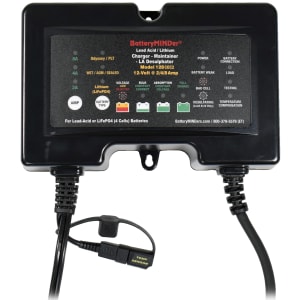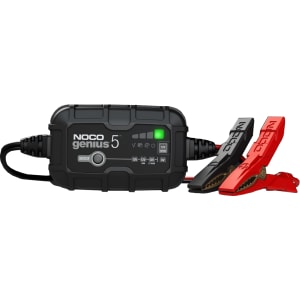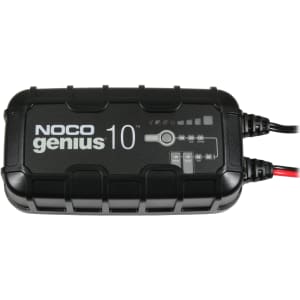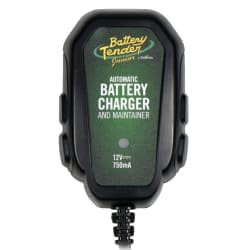What Size Battery Charger Do I Need?
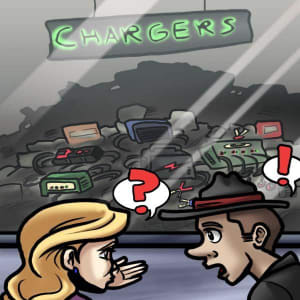
Let me start with a disclaimer: BatteryStuff.com does not sell those cheap, off-the-shelf battery chargers often found at retail outlets and certain other online stores. We cater specifically to microprocessor-controlled chargers, also known as smart chargers and maintainers. All our chargers are reviewed, tested, and selected based on function, reliability, and durability.
Our smart battery chargers utilize computer-generated algorithms designed to charge specific battery chemistries, such as flooded, AGM, Gel, or lithium batteries. Simply put, most of our chargers collect information from the battery and/or user and adjusts the charge current and voltage based on this information.
This allows the battery to be charged quickly, correctly, and completely when using a smart charger. Most of the chargers we sell can remain connected to a battery indefinitely and will not overcharge or damage a battery.
Simple steps to select the right Battery Charger for your needs:
Step 1: Choosing a Charger Based on Battery Type
To select the right charger, you need to know your battery’s chemistry.
Common battery types found in most applications are maintenance-free, wet cell (flooded), AGM (absorbed glass mat), gel cell, VRLA (valve-regulated lead acid), or lithium.
We can often recommend a single charger with a multi-amp and profile setting for those with various battery types. The benefit to these types of chargers is you can charge a small motorcycle or ATV battery up to a large deep-cycle marine battery:
Schauer Charge Master CM12A | 12v 1/8/12 Amp Multi-Stage Smart Charger
- Part# CM12A
- Ideal for 4AH to 240 AH
- Works on Flooded, AGM, Gel, and Calcium Lead Acid Batteries
- Fan Cooled
- Ideal for Powersport Batteries, Car & Truck Batteries, or maintaining up to a 240 AH RV battery pack!
BatteryMINDer 128CEC2 | 12v 2/4/8 Amp Smart Charger Maintainer Desulfator
- Part# 128CEC2
- Ideal for 8AH to 240 AH
- Works on PLT (Pure Lead Tin), Odyssey Brand Batteries, Flooded, AGM, Sealed, and Lithium Batteries
- Full-time 100% Pulse Desulfation for Lead Acid Batteries.
- Ideal for Powersport Batteries, Car & Truck Batteries, or maintaining up to a 240 AH RV battery pack!
- Intrusion Protected (water, moisture, dust) to IEC IP 65
Step 2: Determining Battery Size
We don’t mean physical size but the battery capacity, often referred to in an AH (amp/hours) rating.
For example, a typical car battery is about 50 AH but could be as much as 100 AH. So ideally, you would choose a 5 to 10 amp charger that would take about 6-12 hours to recharge if the battery was completely dead.
NOCO Genius 5 | 12v 5 Amp Smart Battery Charger & Maintainer
- Part# GENIUS5
- Ideal for 20AH to 120 AH Batteries!
- Compatible with 6v & 12v: Flooded, Gel, Maintenance-Free & 12v: AGM & Lithium
- Great for maintaining batteries up to 120 AH!
- Intrusion Protected (water, moisture, dust) to IEC IP 65
Another instance would be a marine deep cycle battery rated at 100-amp hours. It would take a 10-amp charger about 11-12 hours to recharge a dead battery to nearly 100% full charge.
To calculate the total charge time for a battery, a good rule of thumb is to divide the battery's amp hour rating by the charger’s amp rating and then add about 10-20% for the smart charging phase to top off the battery.
If you want a quick recharge, look for a charger with more amps. However, remember that a battery’s max charging rate is about 20-25% of its AH rating, so don’t go too high in your charger selection, or you could damage the battery. For those trying to recover a large powersport battery, car or truck battery, or a marine or RV deep cycle battery, we typically recommend the following charger:
NOCO Genius 10 | 12v 10 Amp Smart Battery Charger Maintainer
- Part# Genius10
- Ideal for 20AH to 230 AH Batteries!
- Dual Voltage works on 6v & 12v Batteries
- Compatible with 6v & 12v: Flooded, Gel, Maintenance-Free & 12v: AGM & Lithium
- 2x Faster than the Genius 5: Ideal for those wanting to recover a battery quickly!
- Intrusion Protected (water, moisture, dust) to IEC IP 65
Ultimately, we recommend a charger with an amp rating about 10% of the battery’s AH rating, as it won’t heat up the battery and won’t put too much wear and tear on the charger.
The most important thing is ensuring you have enough charging power to do the required job in your allocated time.
Step 3: Choosing a Battery Charger Based on Desired Outcome
Some folks require a charger to keep their motorcycle, classic car, or aircraft battery charged during the offseason. In these cases, a simple low current charger will work fine since. Others require a faster, more powerful charger to quickly restore a deep cycle trolling motor battery or a higher amperage wheelchair charger for quicker charge times. Other types of chargers and the reasons you might need them:
- Worldwide Input Voltage chargers for use when visiting a foreign country.
- Waterproof chargers for those times when you’re out in the elements
- Chargers that double as power supplies for RV use
- Multi-bank chargers for charging multiple batteries simultaneously
Hopefully, we’ve helped you figure out which is the best charger for your application. Use the link below to see our large selection of battery chargers and 12v/24v trickle chargers.
• Rated article 5 • December 20, 2024 at 11:09 am
• January 31, 2025 at 10:03 am
• Rated article 5 • November 5, 2024 at 9:40 am
• November 5, 2024 at 12:24 pm
• Rated article 5 • October 16, 2024 at 7:08 am
• October 22, 2024 at 8:00 am
• Rated article 5 • August 21, 2024 at 10:22 am
• September 27, 2024 at 11:27 am
• Rated article 5 • January 7, 2024 at 8:18 am
• Rated article 5 • October 20, 2023 at 5:41 am
• Rated article 5 • October 20, 2023 at 9:23 am
• Rated article 5 • April 3, 2023 at 3:33 am
• Rated article 5 • April 28, 2023 at 10:14 am
• Rated article 5 • February 12, 2023 at 8:17 pm
• Rated article 5 • February 16, 2023 at 2:41 pm
• Rated article 5 • January 22, 2023 at 9:04 am
• Rated article 5 • January 23, 2023 at 1:22 pm
• Rated article 5 • December 10, 2022 at 10:14 am
• Rated article 5 • December 13, 2022 at 1:22 pm
• Rated article 5 • October 25, 2022 at 5:59 pm
• Rated article 5 • December 13, 2022 at 12:35 pm
• Rated article 5 • November 30, 2021 at 11:57 am
• Rated article 5 • December 3, 2021 at 10:29 am
• Rated article 5 • November 1, 2021 at 12:09 pm
• Rated article 5 • November 1, 2021 at 1:22 pm
• Rated article 5 • November 2, 2021 at 7:22 am
• Rated article 5 • November 2, 2021 at 7:09 am
• Rated article 5 • September 9, 2021 at 4:56 pm
• Rated article 5 • November 1, 2021 at 11:35 am
• Rated article 5 • September 4, 2021 at 1:00 am
• Rated article 5 • November 1, 2021 at 2:11 pm
• Rated article 2 • June 14, 2020 at 9:08 pm
• Rated article 5 • June 15, 2020 at 2:32 pm
• Rated article 5 • April 20, 2020 at 7:57 pm
• Rated article 5 • April 21, 2020 at 7:57 am
• Rated article 5 • January 21, 2020 at 11:36 am
• Rated article 5 • January 21, 2020 at 11:55 am
• Rated article 5 • December 3, 2019 at 10:15 pm
• Rated article 5 • December 13, 2019 at 8:30 am
• January 15, 2017 at 4:32 am
• January 17, 2017 at 10:52 am
AC power consumption (with 60w power supply) 100-240 VAC, 50/60 Hz, 2.1 A
Ac Power consumption (with 80w power supply) 100-240 VAC, 50/60 Hz, 2.0 A
DC Power consumption: 12 VDC, 6.67 A Any help or explanations are appreciated, as I am brand new to trying to figure this stuff out. :)
• July 4, 2016 at 9:56 am
• January 25, 2017 at 8:26 am
I’m doing a summer project and was wondering about deep cycle batteries.
I understand that when connecting the same batteries in parallel, it will have the same voltage but will double up in the Ah. However, let’s say I am charging the battery in parallel.
Let’s assume that the rating max charging current for a battery is 5 Amps and I have an 8 Amp charger. Would connecting the battery in parallel be able to handle 8 Amp charger? (Meaning that the rating max charge current will be 10 amps instead of 5 amps?? Or would the max rating current to charge is still 5 amps and can not handle it. I was wondering about this because wouldn’t that mean the battery will charge slower if it only takes in 5 amps? I guess it might be better for the battery life but was wondering if it could handle it) Thanks for your help.
• Rated article 5 • June 28, 2016 at 11:29 pm
• January 19, 2017 at 10:10 am
• June 24, 2016 at 7:03 am
• January 18, 2017 at 11:49 am
• Rated article 5 • June 22, 2016 at 7:48 am
• January 18, 2017 at 8:11 am
• Rated article 5 • May 25, 2016 at 2:16 pm
• Rated article 5 • May 26, 2016 at 1:48 pm
• Rated article 5 • May 2, 2016 at 11:12 pm
• Rated article 5 • May 3, 2016 at 6:53 am
• April 27, 2016 at 8:59 pm
• Rated article 5 • April 29, 2016 at 6:22 am
• April 16, 2016 at 11:57 am
• April 18, 2016 at 9:56 am
Thanks….Herb
• December 4, 2014 at 6:53 am
• Rated article 5 • December 30, 2014 at 8:55 am
Thanks Art
• Rated article 5 • November 14, 2014 at 10:22 am
• Rated article 5 • November 19, 2014 at 2:26 pm
• October 28, 2014 at 6:55 am
• Rated article 5 • November 18, 2014 at 2:08 pm
• Rated article 5 • October 24, 2014 at 9:24 pm
• Rated article 5 • November 18, 2014 at 1:13 pm
• Rated article 5 • October 24, 2014 at 7:02 am
• Rated article 5 • November 18, 2014 at 1:06 pm
The light is supposed to turn green when the batteries are fully charged but I have to keep stopping as the batteries are bubbleing and getting hot ? is this ok ? I am not sure if the charger is a 3 stage or not ? some adverts say it is , some just say 24v ?
Thankyou Steve
• September 14, 2014 at 2:35 am
• Rated article 5 • September 25, 2014 at 11:01 am
• August 15, 2014 at 2:46 pm
• August 3, 2014 at 9:31 am
My current charger has three “banks”. One for the house batteries (in series), one for the port engine, and one for the stbd engine. I also have a battery for the generator which is not on a charger. If I’m buying a new charger, I’d like to get one with four banks to cover all the batteries. The engine and generator starting batteries are all wet cell.
Can you recommend some choices for a battery charger.
From the SPEC Sheet for the Optima Batteries (http://www.optimabatteries.com/en-us/shop/bluetop/optima-batteries-8027-127-d27m-27-bluetop-marine-deep-cycle-starting/), recommended charging info is: Recommended Charging Information
Alternator: 13.65 to 15.0 volts
Battery Charger: 13.8 to 15.0 volts; 10 amps maximum; 6-12 hours approximate
Float Charge: 13.2 to 13.8 volts; 1 amp maximum; (indefinite time at lower voltages)
Rapid Recharge (Constant voltage charger): Maximum voltage 15.6 volts. No current limit as long as battery temperature remains below 125°F (51.7°C). Charge until current drops below 1 amp.
Cyclic or Series String Applications:: 14.7 volts. No current limit as long as battery temperature remains below 125°F (51.7°C). When current falls below 1 amp, finish with 3 amp constant current for 1 hour.
All limits must be strictly adhered to. Performance Data
Cold Cranking Amps: 800
Cranking Amps: 1000
Nominal Voltage: 12 volts
Open Circuit Voltage (fully charged): 13.1 volts
Internal Resistance (fully charged): 0.0025 ohms
Capacity: 66 Ah (C/20)
Reserve Capacity: BCI: 140 minutes (25 amp discharge, 80°F (26.7°C), to 10.5 volts cut-off)
• Rated article 5 • July 30, 2014 at 3:05 pm
• August 15, 2014 at 2:45 pm
you!?!?
• July 7, 2014 at 5:47 am
• June 20, 2014 at 12:11 pm
• Rated article 5 • June 17, 2014 at 5:43 am
20/hr rate-100/capacity AH10hr/rate-92; CCA-1150; RC-205. Charger is a noco genius 4 bank (40 amp total). Previous set up had 2 positive wires (6g i think) coming from bow and connected to battery 1 + and the other to battery 2 +…why? I took the one off and just use the main + cable on battery 3 and the neg on battery 1 and +/- jumper between batteries 1/2/3. Does jumper have to be same size as main power wire? what guage do you recommned for jumpers? Does my system seem right…and what is the best way to test voltage output? • April 9, 2014 at 12:07 pm
• December 9, 2013 at 3:02 am
• May 29, 2013 at 7:41 pm
• May 30, 2013 at 8:11 am
• Rated article 5 • July 21, 2014 at 1:57 pm
• Rated article 4 • April 14, 2013 at 2:09 am
Thank you.
• Rated article 5 • April 12, 2013 at 2:27 pm
• April 12, 2013 at 2:36 pm
I‘m trying to size a multi-bank battery charger for a boat. It will float charge 2 lead acid starting batteries, one generator starting battery, and a house bank consisting of (6) 220AH 6V golf cart batteries connected series-parallel (The house system is 110-120VAC). I have a 5000W inverter and a 7500W gas-powered Kohler generator to produce AC when anchored/underway. The load on the house bank batteries will be no more than 20a (DC), but will vary over my intended use time of 12-16 hours between charging opportunities. Im looking for a fast charge time, because occasionally the charge source will be the gas generator, and the less that runs, the better. I suspect my inverter is sized with a greater capacity than my battery bank can safely support. But it‘s what I have. I would also love to be able to manually select the charging source for the house bank to switch between the engines’ alternators or a solar array in addition to the generator. Everything is 12V. Two questions: Do you see any holes in my plan, and for the charger is my best option to get as many amps as I can afford? Thanks in advance!
• March 17, 2013 at 7:33 am
GPS unit (12VDC – not sure, but probably very low draw and only for 5-10 min no more than 2x/night)
Laptop (110VAC) ~2.0 amps for 3-8 hrs/night
Cell phone (USB if available on power unit, AC adapter if not ~200mA not every cycle, but when needed ~2 hr recharge)
Tablet computer (AC adapter probably not used every time – 2000mA for 3-5 hrs when used) Several places in your material and others I‘ve read, the statement is made that one should get the highest Ah rating they can. I think these materials have been about higher and possibly shorter-term draw in all cases, but I‘m not sure. Other material says, for the type of low power/long usage above, one should use something with an Ah rating of only about twice what they would probably use in one session on average, so as not to draw the battery down too much in one night, but enough of the total so the cycling is deep enough to preserve battery life by the proper amount of cycling (or something like that ;-). Still other places, I‘ve read that it is better to draw down the battery less (5-10% of capacity) to increase the lifespan of the battery. All of this has me confused. I am trying to figure out two last things before I can figure out what I need: 1.) Should I limit my choice of Ah rating to a lower number (twice my need per cycle) for my kind of usage? 2.) This may be outside your subject matter expertise, or depend on specific unit features, but I also need to know if built-in inverters draw power when nothing is plugged into them. I haven‘t been able to find anything on that question.
• March 9, 2013 at 8:48 am
• March 11, 2013 at 10:01 am
• February 7, 2013 at 12:33 pm
• February 7, 2013 at 1:49 pm
• February 5, 2013 at 10:01 am
• February 5, 2013 at 4:26 pm
• February 4, 2013 at 6:05 pm
• February 5, 2013 at 12:09 pm
• Rated article 1 • May 31, 2016 at 4:44 am
• Rated article 5 • June 3, 2016 at 2:15 pm
• Rated article 5 • January 24, 2013 at 5:50 am
• January 24, 2013 at 9:11 am
• January 8, 2013 at 9:42 am
• January 8, 2013 at 10:01 am
• January 10, 2013 at 6:35 am
• January 10, 2013 at 8:56 am
• Rated article 5 • January 23, 2013 at 8:52 am
• January 23, 2013 at 9:08 am
• December 29, 2012 at 1:35 pm
• January 2, 2013 at 8:33 am
• December 27, 2012 at 7:46 am
• December 28, 2012 at 8:59 am
• December 15, 2012 at 7:33 am
• December 17, 2012 at 8:39 am
• December 5, 2012 at 2:16 pm
• December 5, 2012 at 4:07 pm
But I‘m not sure if I understood everything right, so I‘ll need some guidance.
I have a electric van, batteries: 18 in series per row, 3 of those rows in parallel, mounting to 54 batteries. They are AGM 12v 100Ah.
What type of charger and how many of them do I need?
• Rated article 5 • November 13, 2012 at 1:58 pm
• November 13, 2012 at 4:19 pm
Converter, 40 amp, has never fully charged the three units with the ignition on; nor even the house and genset batteries with the ignition off. Now the converter is not operating. I need a converter/charger that will do the job through perhaps a change in wiring?
• November 13, 2012 at 12:06 pm
• November 13, 2012 at 12:44 pm
• October 20, 2012 at 4:20 pm
• October 23, 2012 at 10:26 am
• October 12, 2012 at 5:03 am
• October 12, 2012 at 9:16 am
• Rated article 3 • July 31, 2014 at 9:19 am
• October 4, 2012 at 4:26 am
• October 4, 2012 at 8:36 am
• Rated article 1 • September 18, 2012 at 11:21 am
• September 20, 2012 at 9:10 am
• Rated article 5 • September 11, 2012 at 10:34 am
• September 11, 2012 at 11:05 am
• Rated article 5 • August 24, 2012 at 10:30 pm
• Rated article 5 • July 19, 2012 at 12:30 am
• July 19, 2012 at 8:30 am
• Rated article 3 • July 7, 2012 at 12:44 pm
• July 9, 2012 at 9:40 am
• Rated article 5 • April 20, 2012 at 1:09 pm
• Rated article 5 • April 20, 2012 at 5:52 am
Mike
• Rated article 5 • March 5, 2012 at 3:55 am




